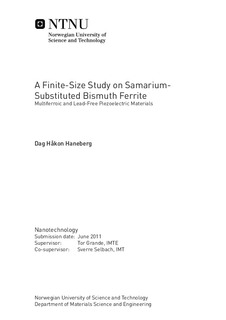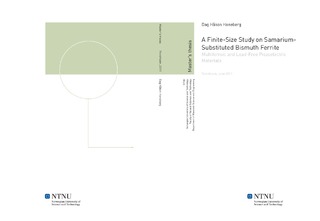| dc.description.abstract | Multiferroic materials combine two or more ferroic orders such as ferroelectricity, ferromagnetism and ferroelasticity. They have a great interest for the development of the next generations of digital electronic memory devices. Bismuth ferrite has shown to posess both ferroelectric and magnetic order at room temperature, which makes it both scientifically and comercially interesting.The negative impact on the environment by using lead in mass-produced units has made development of lead-free piezoelectric materials for use in sensors, actuators and transducers prioritized and samarium substituted bismuth ferrite has shown to posess a piezoelectric response high enough to be considered for commercial applications. In this project work, 10mol% samarium substituted bismuth ferrite, Bi_{0.9}Sm_{0.1}FeO_{3}, powders have been synthesized using a wet-chemical method and calcined to a range of temperatures to achieve a range of nanocrystalline sizes in the powders. These powders has been investigated using X-ray diffraction (XRD), Rietveld refinement and differential scanning calorimetry (DSC). The powders have also been milled, pressed and sintered to pellets for ferroelectric and piezoelectric testing. The crystal structure was found to belong to the R3c group as for bismuth ferrite, BiFeO_{3}, but the unit cell geometry is changed slightly, and the ferroelectric polarizability is lowered in the case of samarium substitution. This fact is interesting regarding piezoelectricity by thereby increasing the ability to achieve a higher piezoelectric response. No results were achieved from ferroelectric and piezoelectric measurement due to the conductivity found in the sintered pellets were too high, probably due to secondary sillenite phases found in the material. There has been found a finite size effect of a decrease in unit cell volume and tetragonality, of which the decrease in volume is contradictory to the expectations. There is also clear finite size effects on the decrease of cooperative displacement of cations, a measure for the polarization, and for the lowering of the ferroelectric phase transition temperature. The finite size effect for the ferroelectric phase transition has not been reported before. The magnetic phase transition temperature also show a decrease as a clear finite size effect. A linear relationship between electric polarization and magnetic ordering has also been observed in this project. The results from this project contributes to the understanding of material properties of BiFeO_{3} and derived compositions by an investigation of substitution effects and finite size effects. The results presented here motivates further research on these materials. | nb_NO |

